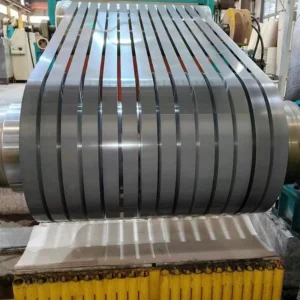Introduction
In today’s energy-conscious world, the focus on reducing electricity losses and improving system performance has never been more important. One material at the heart of this shift is cold rolled grain oriented steel—a highly engineered type of silicon steel used predominantly in transformer cores.
With its unique grain alignment and superior magnetic properties, this steel enables the efficient transmission of electricity in power grids, substations, and renewable energy systems. As Europe strengthens its green transition and Middle Eastern countries expand their energy infrastructure, cold rolled grain oriented steel becomes a key enabler of energy efficiency and system reliability.
This article provides a deep technical look at this essential material, from its properties and production process to its strategic role in modern energy systems.
What Is Cold Rolled Grain Oriented Steel?
Cold rolled grain oriented steel (commonly abbreviated as CRGO) is a type of electrical steel produced through a controlled rolling and annealing process that aligns the grain structure of the steel in the rolling direction. This grain orientation greatly enhances the material’s magnetic properties, especially in one direction, making it ideal for use in transformers.
Unlike non-grain-oriented electrical steel, which has a random grain structure, CRGO is engineered to minimize core losses and maximize magnetic permeability. These attributes translate to higher energy efficiency, lower operational costs, and improved thermal performance in power transmission applications.
Manufacturing Process
The production of cold rolled grain oriented steel is a complex, multi-stage process that requires advanced metallurgical control. The steps include:
- Hot Rolling: The base steel is hot rolled to reduce thickness and prepare it for cold rolling.
- Cold Rolling: This further refines the thickness and introduces strain that is crucial for later grain orientation.
- Decarburization Annealing: Reduces carbon levels to prevent magnetic aging and hysteresis losses.
- Grain Orientation Annealing: A high-temperature heat treatment that induces the preferred grain alignment.
- Coating Application: An insulating coating is applied to improve electrical resistance and reduce eddy current losses.
- Domain Refinement: Laser scribing or mechanical etching is used to create magnetic domain patterns that further reduce core loss.
Each step is precisely controlled to achieve the magnetic and physical properties required for high-performance transformer cores.
Key Properties and Benefits
- Low Core Loss: Essential for reducing energy waste in static magnetic fields.
- High Magnetic Permeability: Enhances the flow of magnetic flux in the rolling direction.
- Superior Insulating Coating: Improves interlaminar resistance and corrosion protection.
- Thermal Stability: Maintains performance under high operating temperatures.
- Dimensional Precision: Enables accurate stacking and assembly of transformer laminations.
These properties make cold rolled grain oriented steel indispensable in high-efficiency power systems, where performance, reliability, and energy savings are critical.
Applications
1. Power Transformers
CRGO is used in the core laminations of distribution and power transformers. The steel’s grain alignment significantly reduces no-load losses, helping utilities and grid operators meet stringent efficiency targets.
2. Instrument Transformers
In current and voltage transformers used for measurement and control, cold rolled grain oriented steel ensures signal accuracy and thermal consistency.
3. Renewable Energy Systems
Transformer cores in wind and solar farms must operate reliably under fluctuating loads. CRGO steel provides the stable magnetic characteristics required for such demanding applications.
4. Smart Grids
As digital infrastructure is integrated into power systems, the need for precise voltage regulation increases. CRGO helps minimize losses and supports grid efficiency in intelligent energy networks.
Regional Market Outlook
Europe: With the EU committed to cutting emissions and upgrading aging electrical infrastructure, demand for high-efficiency transformer components is surging. CRGO steel plays a vital role in achieving energy savings across power networks, and its use is encouraged under the EU’s Ecodesign and Green Deal policies.
Middle East: National strategies like Saudi Vision 2030 and the UAE Energy Strategy 2050 are driving the expansion of transmission networks and renewable energy projects. Cold rolled grain oriented steel is essential to ensure long-term system efficiency, particularly in desert climates where transformers face thermal stress and long-distance load distribution.
Technical Innovations
Recent advancements in cold rolled grain oriented steel production are enhancing its performance and reducing its environmental footprint:
- Laser Domain Refinement: A non-contact technique that reduces core loss without compromising mechanical strength.
- Thin Gauge CRGO: Offering higher performance in compact transformer designs, increasingly demanded in urban and offshore applications.
- Eco-Friendly Coatings: New coatings provide better adhesion, corrosion resistance, and thermal properties while reducing manufacturing emissions.
- AI-Driven Quality Control: Real-time monitoring systems improve consistency and allow producers to meet tight tolerance specifications.
Such innovations are critical for achieving high energy efficiency while maintaining cost-effectiveness and manufacturability.
Environmental and Economic Impact
Using cold rolled grain oriented steel in transformer cores significantly reduces total electricity loss in a power grid. These savings translate into reduced greenhouse gas emissions and lower energy costs for both providers and end-users. For example:
- Transformers using CRGO steel can reduce no-load losses by up to 30%.
- Longer transformer lifespan due to better heat resistance lowers maintenance and replacement costs.
- Improved grid stability and power quality reduce economic losses due to outages or inefficient transmission.
In a region like the Middle East, where high temperatures and long-distance power transmission are common, the operational savings from CRGO-based transformers are especially significant.
Challenges in Production and Supply
- Raw Material Supply: The availability of high-purity silicon and alloying materials can fluctuate.
- Manufacturing Complexity: Producing CRGO steel to exacting standards requires advanced equipment and skilled labor.
- Cost Sensitivity: Premium performance comes at a higher production cost, making efficient manufacturing critical.
- Import Barriers and Trade Policies: Some regions have tariffs or quotas affecting international supply chains.
These challenges have prompted several nations to invest in domestic production capabilities to ensure security of supply and quality control.
Future Outlook
The global market for cold rolled grain oriented steel is expected to grow steadily in the coming decade. Drivers include:
- Expansion of renewable energy systems
- Infrastructure upgrades in aging power grids
- Rising demand for high-efficiency transformers in smart cities
- Tighter regulatory standards for energy loss
To meet this demand, manufacturers will need to continue innovating, enhancing production efficiency, and forming global partnerships that ensure a reliable supply chain.
Conclusion
Cold rolled grain oriented steel is more than just a specialty material—it is a cornerstone of efficient, reliable, and sustainable energy systems. From Europe’s high-tech power infrastructure to the Middle East’s rapidly growing energy market, CRGO steel enables the safe and efficient transmission of electricity across thousands of kilometers.
As energy demands grow and decarbonization efforts accelerate, investing in high-quality transformer materials like cold rolled grain oriented steel is not just smart engineering—it’s a strategic necessity.
Let me know if you’d like this formatted in HTML, exported as a Word document, or adapted into a shorter format for social media or email marketing.




